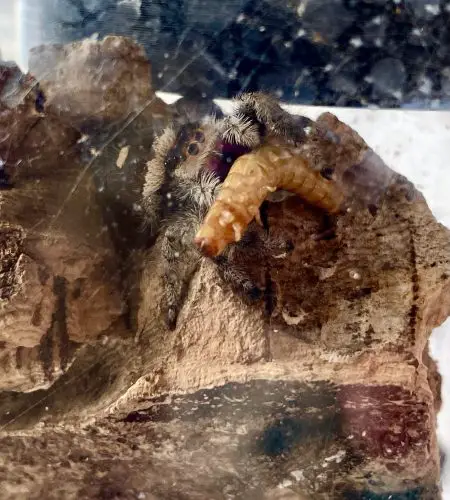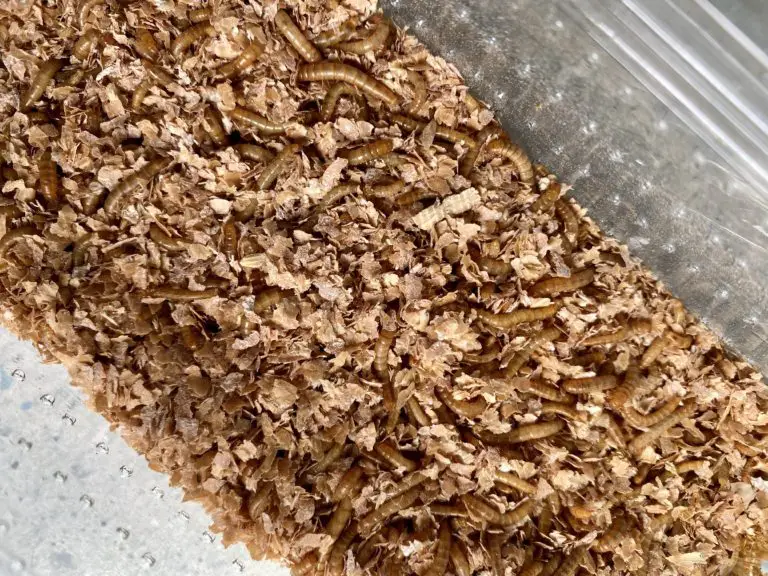Feeding a Jumping Spider
No matter what pet you own, feeding them is essential, and jumping spiders are no different. However, these little creatures have a unique diet compared to other pets people commonly own.
Jumping spiders hunt their prey in the wild, eating them live. If you’re keeping a pet spider, you should strive to offer the exact same experience.
The Eating Habits of a Jumping Spider
Frequency
You might be wondering how often you should feed your jumping spider; this is a very common query. Knowing the feeding frequency needed for your pet spider is essential, but this can differ depending on the spider’s age, species, and sex.
Males are less likely to eat as frequently as female spiders, most likely due to their smaller size. They may only need to be fed every 10 days or so.
Females, on the other hand, will need to be fed more frequently, around every 5 days. They may even need to be fed daily if they are gravid or have recently laid an egg sac.
Young spiders will need to be fed more frequently than adult jumping spiders, around 2-3 times per week.
Understanding the frequency of your spider’s meals is important to the spider’s health, especially if you want to avoid overfeeding. Overfeeding can be dangerous to a spider as it can cause their abdomen to bloat, which can cause their abdomen to rupture.
Quantity
Again, how much your spider eats will rely on the age, size, and species of jumping spider you own. However, you shouldn’t give them a lot of food, as they are unlikely to eat it all. If your spider has a large abdomen, it is likely to be full and not want to eat. Similar to how often a jumping spider is fed, the quantity of food it eats can also cause health issues related to overfeeding.
A good rule of thumb to follow is to give your spider about half their body size in prey. For example, if your jumping spider is 1 inch long, you could give them a fly that is half an inch long.
Jumping spiders will eat as much as they need and leave the rest. You can then remove the uneaten prey from your spider’s enclosure to prevent it from decomposing and attracting bacteria.
Hydration
Before keeping spiders, some people will wonder, “Do spiders drink water?” It might be a surprise to learn that spiders – including jumping spiders – drink water, although most of the moisture they need will be from eating insects, particularly worms. When they drink water, jumping spiders do so by suction, not through their chelicerae.
You must offer fresh water daily to ensure your jumping spider stays healthy and hydrated. Most spiders will drink water when their enclosures are misted, but offering a shallow dish of water will provide extra humidity as well as a reliable drinking source. Do not use a deep water dish, as this will risk drowning your spider.
When misting the enclosure, be sure to aim at the opposite side to where your spider is. You want to ensure the enclosure walls have small water droplets, as these are the perfect size for spiders to maneuver around and drink from.
The Best Feeder Insects
Another popular question is “what do jumping spiders eat?” Well, some of the most popular feeder insects for a pet jumping spider diet include:
Flies
Flies are a popular feeder insect for pet jumping spiders, as they are not only easy to find but are also full of nutrients and protein.
Below, you will find a list of flies that are common food options for jumping spiders:
Bluebottles
Greenbottles
Fruit flies
As previously mentioned, the age and size of the jumping spider are factors when choosing the type of fly you use as prey. Very young spiders can eat fruit flies before moving on to greenbottles when they get bigger, then the same happens as they move on to bluebottles. You can put multiple flies in the enclosure at one time for your jumping spider to eat.
However, if you buy the flies as pupae, you do not have to wait for them to hatch before feeding them to your spider.
Feeding jumping spiders flies can also give them an active hunting experience; they will chase down the fly and pounce on it, which is good for their physical and mental health. You can watch a male regal jumping spider in action here.
Worms
Worms, like mealworms or wax worms, can be a great option for jumping spider food. They provide essential nutrients and protein and can be found in most pet stores.
However, it is essential to ensure they are not left alive and uneaten in the spider’s enclosure. This is due to the risk mealworms possess to jumping spiders; mealworms can quickly burrow into the substrate of the enclosure and will eventually change into their beetle form, and these beetles have enough strength to injure and potentially kill your jumping spider.
As such, it is necessary to only give your jumping spider one mealworm at a time. If you are feeding your spider multiple mealworms, make sure they are dead before giving them to your pet, or monitor your spider as it eats.
Crickets
Similar to flies and worms, crickets come in a range of sizes. Pet shops will sell a variety, from micro crickets to larger and even jumbo ones. This means they can be used to feed spiders of all ages.
Crickets contain a significant amount of nutrients and protein, making them a great option for spiders of all sizes.
They are also active, which makes them even more appealing to a jumping spider. Your spider will chase and pounce on a cricket, mimicking hunting in the wild.
What You Should Avoid Feeding Your Jumping Spider
Jumping spiders are naturally very timid, meaning they can be easily scared. As such, it is essential to avoid feeding your spider anything that could startle them and cause them to panic.
Ants
Ants are not good for jumping spiders to eat for a number of reasons:
They are very active, so can easily scare a spider
They have a stinger
They can be very large
Ants, in the wild, would be the predators of jumping spiders, so it is natural for them to be scared of them.
Spiders
It is not recommended to feed your jumping spider another spider. This is because spiders are natural predators of each other, and so a spider could easily eat your pet jumping spider.
In addition, while it might seem like a good idea to feed your spider a spider that is the same size as them, this can be very dangerous. If the spiders are the same size, they will fight and can cause serious injuries to each other, or even death.
Gut Loading Feeder Insects
For some of the insects jumping spiders eat in captivity, it is necessary to gut feed. Gut feeding refers to the process of feeding the live spider food a healthy and nutritious diet, which will ensure the jumping spider receives a fulfilling and beneficial meal.
You can buy a range of products from pet stores or online to do this, but you can also make your own gut loading formula using:
Carrots
Apples
Bananas
Celery
Once you have gathered your ingredients, cook them until they are soft, then puree them. You can then either feed the insects to your spider, or you can put the pureed formula in a shallow dish and let the insects feed on it.
The insects should eat the formula for a few hours before feeding them to your jumping spider.
Storing Feeder Insects
Once you have your feeder insects, it is essential to store them correctly. It is best to keep them in a container with gaps for air to circulate, so they do not suffocate. You should keep the insects in a cool, dry place, out of the reach of children and pets.
It is also essential to keep the insects in a container that has a lid, as you do not want them to escape and become a pest in your home. The cold of being stored in a refrigerator will put many feeder insects to sleep, meaning they will be slower and easier to catch once put in the jumping spider enclosure.
If you are keeping the insects in a refrigerator, make sure they are in a sealed container and are not in contact with any other food.


